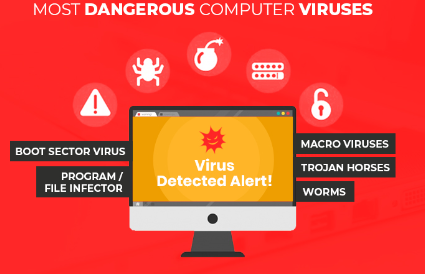Computer Virus: Understanding the Threat to Digital Security
Introduction
Computer viruses have become a significant concern in today’s digital landscape. These malicious software programs can cause severe damage to computer systems, compromising data, disrupting operations, and compromising user privacy. Understanding computer viruses is crucial for individuals and organizations to protect their digital assets. In this blog post, we will provide a comprehensive overview of computer viruses, exploring their definition, types, modes of transmission, and preventive measures of computer virus. By gaining insights into the world of computer viruses, we can better equip ourselves to safeguard our digital environments

- What is a Computer Virus?
A computer virus is a type of malicious software that replicates itself and spreads from one computer to another. It attaches itself to legitimate programs or files, altering their functionality or damaging them. Viruses are designed to execute unwanted actions, such as deleting files, corrupting data, stealing information, or disrupting system operations. They can infect both individual computers and entire networks, causing significant harm to individuals, businesses, and even governments. - Types of Computer Viruses
Computer viruses come in various forms, each with its own characteristics and methods of attack. Some common types of computer viruses include:
a) File Infectors: These viruses infect executable files, such as .exe or .com files. When an infected file is executed, the virus activates and spreads to other files on the system.
b) Boot Sector Viruses: These viruses target the boot sector of storage devices, such as hard drives or flash drives. They infect the boot sector, making them active during the booting process and allowing the virus to spread when the infected device is accessed.
c) Macro Viruses: Macro viruses infect documents or spreadsheets that contain macros, such as those created in Microsoft Office. When the infected document is opened, the virus executes and may spread to other documents.
d) Polymorphic Viruses: Polymorphic viruses have the ability to change their code and appearance, making it difficult for antivirus software to detect and remove them.
e) Worms: While technically not viruses, worms are self-replicating programs that spread across networks, exploiting vulnerabilities to infect other computers. They often cause network congestion and system slowdowns.
- Modes of Transmission
Computer viruses can spread through various means, taking advantage of vulnerabilities or user actions. Some common modes of transmission include:
a) Email Attachments: Viruses can be transmitted through email attachments. Users who open infected attachments unknowingly execute the virus, allowing it to infect their system and spread to others through their contact list.
b) File Sharing: Peer-to-peer file-sharing networks and unauthorized software downloads can expose users to infected files. When these files are executed, the virus gains access to the system and can propagate further.
c) Infected Websites: Visiting compromised or malicious websites can lead to drive-by downloads, where viruses are automatically downloaded and executed without the user’s consent.
d) Removable Media: Viruses can spread through infected USB flash drives, external hard drives, or other removable media. When the infected media is connected to a computer, the virus can transfer to the system.
e) Network Vulnerabilities: Exploiting vulnerabilities in network protocols or services, viruses can spread across interconnected systems, infecting multiple computers within a network.
- Preventive Measures and Mitigation
Protecting against computer viruses requires a proactive approach and adherence to good security practices. Some preventive measures to consider include:
a) Use Antivirus Software: Install reputable antivirus software and keep it up to date. Regularly scan your system for viruses and malware.
b) Keep Software Updated: Apply software updates and security patches promptly. This helps address vulnerabilities that viruses may exploit.
c) Exercise Caution with Email: Be cautious when opening email attachments, especially from unknown sources. Avoid clicking on suspicious links in emails.
d) Download from Trusted Sources: Download software and files from reputable sources. Avoid downloading files from unknown websites or peer-to-peer networks.
e) Use Strong Passwords: Secure your accounts with strong and unique passwords. Avoid reusing passwords across multiple accounts.
f) Enable Firewalls: Enable firewalls on your computer and network devices to filter incoming and outgoing network traffic.
g) Educate Users: Provide security awareness training to educate users about the risks associated with viruses and the importance of safe computing practices.
h) Backup Data Regularly: Maintain regular backups of essential data. In the event of a virus infection, backups can help restore lost or corrupted files.
- Responding to Virus Infections
In the unfortunate event of a virus infection, prompt action can help mitigate the damage. Steps to consider when responding to a virus infection include:
a) Isolate Infected Systems: Disconnect infected systems from the network to prevent the virus from spreading further.
b) Run Antivirus Scans: Use updated antivirus software to scan and remove the virus from infectedsystems. Follow the recommended actions provided by the antivirus software.
c) Restore from Backups: If possible, restore infected systems from clean backups to ensure the removal of the virus and the recovery of compromised data.
d) Patch Vulnerabilities: Identify and patch any vulnerabilities that the virus exploited to gain access to the system. This helps prevent future infections.
e) Update Security Measures: Review and update security measures, such as antivirus software, firewalls, and intrusion detection systems, to enhance protection against future virus attacks.
Conclusion
Computer viruses pose a significant threat to the security and integrity of digital systems. Understanding the types of viruses, their modes of transmission, and preventive measures is essential for individuals and organizations to protect themselves from these malicious entities. By implementing robust security measures, practicing safe computing habits, and staying informed about the latest threats, we can mitigate the risks associated with computer viruses. Remember, prevention is key in maintaining a secure digital environment. Stay vigilant, keep your systems updated, and adopt a proactive approach to ensure the safety of your digital assets.
